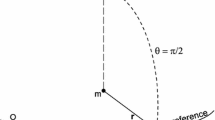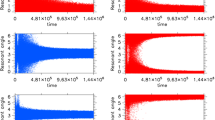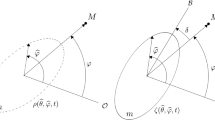Abstract
Close-in co-orbital planets (in a 1:1 mean-motion resonance) can experience strong tidal interactions with the central star. Here, we develop an analytical model adapted to the study of the tidal evolution of those systems. We use a Hamiltonian version of the constant time-lag tidal model, which extends the Hamiltonian formalism developed for the point-mass case. We show that co-orbital systems undergoing tidal dissipation favour either the Lagrange or the anti-Lagrange configurations, depending on the system parameters. However, for all range of parameters and initial conditions, both configurations become unstable, although the timescale for the destruction of the system can be larger than the lifetime of the star. We provide an easy-to-use criterion to determine whether an already known close-in exoplanet may have an undetected co-orbital companion.







Similar content being viewed by others
Notes
Niederman et al. (2020) give an expression of the coefficients of this matrix in terms of integrals depending on some parameters.
The remaining degree of freedom is due to the conservation of the total angular momentum of the system.
Four, with \(\displaystyle {g_2}\).
Old means that its age is significant with respect to its expectancy of life.
 (qoppa) and
(qoppa) and  [sampi, see Eq. (59)] are archaic Greek letters.
[sampi, see Eq. (59)] are archaic Greek letters.Normalized by \(\displaystyle {m\bar{a}^2\eta }\).
References
Adams, F.C., Bloch, A.M.: On the stability of extrasolar planetary systems and other closely orbiting pairs. Mon. Not. R. Astron. Soc. 446, 3676–3686 (2015)
Beaugé, C., Sándor, Z., Érdi, B., Süli, Á.: Co-orbital terrestrial planets in exoplanetary systems: a formation scenario. Astron. Astrophys. 463, 359–367 (2007)
Claret, A., Cunha, N.C.S.: Circularization and synchronization times in Main-Sequence of detached eclipsing binaries II. Using the formalisms by Zahn. Astron. Astrophys. 318, 187–197 (1997)
Correia, A.C.M., Laskar, J.: Mercury’s capture into the 3/2 spin-orbit resonance as a result of its chaotic dynamics. Nature 429, 848–850 (2004)
Correia, A.C.M., Laskar, J.: Tidal Evolution of Exoplanets, pp. 239–266. University of Arizona Press, Tucson (2010)
Correia, A.C.M., Boué, G., Laskar, J., Rodríguez, A.: Deformation and tidal evolution of close-in planets and satellites using a Maxwell viscoelastic rheology. Astron. Astrophys. 571, A50 (2014)
Correia, A.C.M., Bourrier, V., Delisle, J.B.: Why do warm Neptunes present nonzero eccentricity? Astron. Astrophys. 635, A37 (2020)
Cresswell, P., Nelson, R.P.: Three-dimensional simulations of multiple protoplanets embedded in a protostellar disc. Astron. Astrophys. 482, 677–690 (2008)
Danby, J.M.A.: Stability of the triangular points in the elliptic restricted problem of three bodies. Astron. Astrophys. 69, 165 (1964)
Darwin, G.H.: On the secular change in the elements of a satellite revolving around a tidally distorted planet. Philos. Trans. R. Soc. Lond. 171, 713–891 (1880)
Efroimsky, M.: Bodily tides near spin-orbit resonances. Celest. Mech. Dyn. Astron. 112, 283–330 (2012)
Euler, L.: Considerationes de motu corporum coelestium. Novi commentarii academiae scientiarum Petropolitanae. Berlin Acad. 10, 544–558 (1764)
Ford, E.B., Gaudi, B.S.: Observational constraints on Trojans of transiting extrasolar planets. Astron. Astrophys. 652, L137–L140 (2006)
Ford, E.B., Holman, M.J.: Using transit timing observations to search for Trojans of transiting extrasolar planets. Astron. Astrophys. 664(1), L51–L54 (2007)
Gascheau, G.: Examen d’une classe d’équations différentielles et application à un cas particulier du problème des trois corps. C. R. Acad. Sci. Paris 16(7), 393–394 (1843)
Giuppone, C.A., Beaugé, C., Michtchenko, T.A., Ferraz-Mello, S.: Dynamics of two planets in co-orbital motion. Month. Not. R. Astron. Soc. 407, 390–398 (2010)
Giuppone, C.A., Benitez-Llambay, P., Beaugé, C.: Origin and detectability of co-orbital planets from radial velocity data. MNRAS 421(1), 356–368 (2012)
Hara, N.C., Bouchy, F., Stalport, M., Boisse, I., Rodrigues, J., Delisle, J.-B., et al.: The SOPHIE search for northern extrasolar planets. XVI. HD 158259: a compact planetary system in a near-3:2 mean motion resonance chain. Astron. Astrophys. 636, L6 (2020)
Hippke, M., Angerhausen, D.: A statistical search for a population of exo-Trojans in the Kepler data set. ApJ 811, 1 (2015)
Hut, P.: Stability of tidal equilibrium. Astron. Astrophys. 92, 167–170 (1980)
Janson, M.: A systematic search for Trojan planets in the Kepler data. APJ 774, 156 (2013)
Kaula, W.M.: Tidal dissipation by solid friction and the resulting orbital evolution. Rev. Geophys. 2, 661–685 (1964)
Lagrange: Œuvres complètes. Gauthier-Villars, Paris (1772) (1869)
Lainey, V.: Quantification of tidal parameters from Solar System data. Celest. Mech. Dyn. Astron. 126, 145–156 (2016)
Laskar, J., Robutel, P.: Stability of the planetary three-body problem. I. Expansion of the planetary Hamiltonian. Celest. Mech. Dyn. Astron. 62, 193–217 (1995)
Laskar, J., Boué, G., Correia, A.C.M.: Tidal dissipation in multi-planet systems and constraints on orbit fitting. Astron. Astrophys. 538, A105 (2012)
Laughlin, G., Chambers, J.E.: Extrasolar Trojans: the viability and detectability of planets in the 1:1 resonance. Astron. J. 124, 592–600 (2002)
Leleu, A., Robutel, P., Correia, A.C.M.: Detectability of quasi-circular co-orbital planets. Application to the radial velocity technique. Astron. Astrophys. 581, A128 (2015)
Leleu, A., Robutel, P., Correia, A.C.M., Lillo-Box, J.: Detection of co-orbital planets by combining transit and radial-velocity measurements. Astron. Astrophys. 599, L7 (2017)
Leleu, A., Robutel, P., Correia, A.C.M.: On the coplanar eccentric non-restricted co-orbital dynamics. Celest. Mech. Dyn. Astron. 130, 24 (2018)
Leleu, A., Coleman, G.A.L., Ataiee, S.: Stability of the co-orbital resonance under dissipation. Application to its evolution in protoplanetary discs. Astron. Astrophys. 631, A6 (2019)
Lillo-Box, J., Barrado, D., Figueira, P., et al.: The TROY project: searching for co-orbital bodies to known planets. I. Project goals and first results from archival radial velocity. Astron. Astrophys. 609, A96 (2018a)
Lillo-Box, J., Leleu, A., Parviainen, H., et al.: The TROY project. II. Multi-technique constraints on exotrojans in nine planetary systems. Astron. Astrophys. 618, A42 (2018b)
Luhn, J.K., Bastien, F.A., Wright, J.T., Johnson, J.A., Howard, A.W., Isaacson, H.: Retired A stars and their companions. VIII. 15 New planetary signals around subgiants and transit parameters for California planet search planets with subgiant hosts. Astron. J. 157, 149 (2019)
Lyra, W., Johansen, A., Klahr, H., Piskunov, N.: Standing on the shoulders of giants. Trojan Earths and vortex trapping in low mass self-gravitating protoplanetary disks of gas and solids. Astron. Astrophys. 493, 1125–1139 (2009)
Madhusudhan, N., Winn, J.N.: Empirical constraints on Trojan companions and orbital eccentricities in 25 transiting exoplanetary systems. APJ 693(1), 784–793 (2009)
Mignard, F.: The evolution of the lunar orbit revisited. I. Moon Planets 20, 301–315 (1979)
Moeckel, R.: Minimal energy configurations of gravitationally interacting rigid bodies. Celest. Mech. Dyn. Astron. 128, 3–18 (2017)
Munk, W.H., MacDonald, G.J.F.: The Rotation of the Earth; A Geophysical Discussion. Cambridge University Press, Cambridge (1960)
Namouni, F.: Secular interactions of coorbiting objects. Icarus 137, 293–314 (1999)
Nauenberg, M.: Stability and eccentricity for two planets in a 1:1 resonance, and their possible occurrence in extrasolar planetary systems. Astron. J. 124, 2332–2338 (2002)
Niederman, L., Pousse, A., Robutel, P.: On the co-orbital motion in the three-body problem: existence of quasi-periodic horseshoe-shaped orbits. Commun. Math. Phys. 377, 551–612 (2020)
Pierens, A., Raymond, S.N.: Disruption of co-orbital (1:1) planetary resonances during gas-driven orbital migration. MNRAS 442, 2296–2303 (2014)
Pousse, A., Robutel, P., Vienne, A.: On the co-orbital motion in the planar restricted three-body problem: the quasi-satellite motion revisited. Celest. Mech. Dyn. Astron. 128, 383–407 (2017)
Roberts, G.: Linear stability of the elliptic Lagrangian triangle solutions in the three-body problem. J. Dyn. Differ. Equ. 182, 191–218 (2002)
Robutel, P., Pousse, A.: On the co-orbital motion of two planets in quasi-circular orbits. Celest. Mech. Dyn. Astron. 117, 17–40 (2013)
Robutel, P., Niederman, L., Pousse, A.: Rigorous treatment of the averaging process for co-orbital motions in the planetary problem. Comput. Appl. Math. 35(3), 951–985 (2016)
Rodríguez, A., Giuppone, C.A., Michtchenko, T.A.: Tidal evolution of close-in exoplanets in co-orbital configurations. Celest. Mech. Dyn. Astron. 117, 59–74 (2013)
Singer, S.F.: The origin of the Moon and geophysical consequences*. Geophys. J. R. Astron. Soc. 15(1–2), 205–226 (1968)
Vokrouhlický, D., Nesvorný, D.: Transit timing variations for planets co-orbiting in the horseshoe regime. APJ 791, 6 (2014)
Yoder, C.F.: Astrometric and geodetic properties of Earth and the solar system. In: Global Earth Physics: A Handbook of Physical Constants, pp. 1–31. American Geophysical Union (1995)
Acknowledgements
This work was supported by CFisUC (UIDB/04564/2020 and UIDP/04564/2020), GRAVITY (PTDC/FIS-AST/7002/2020), PHOBOS (POCI-01-0145-FEDER-029932), and ENGAGE SKA (POCI-01-0145-FEDER-022217), funded by COMPETE 2020 and FCT, Portugal.
Author information
Authors and Affiliations
Corresponding author
Additional information
Publisher's Note
Springer Nature remains neutral with regard to jurisdictional claims in published maps and institutional affiliations.
This article is part of the topical collection on Exoplanet Dynamics.
Editors: Alessandro Morbidelli, Kleomenis Tsiganis and Alessandra Celletti.
Appendices
Appendices
Notations
We gather here for convenience the notations used throughout this work.Footnote 5
Coefficients of the Hamiltonian \(\displaystyle {\mathcal {H}_4}\) and \(\displaystyle {\mathcal {H}_t^j}\)
First, we give the coefficients depending on \(\displaystyle {\xi }\) of the Hamiltonian \(\displaystyle {\mathcal {H}_4}\). We recall that \(\displaystyle {\mathcal {H}_4}\) is expressed
The coefficients read \(\displaystyle {\left( \text {recall that }\varDelta =\sqrt{2-2\cos \xi }\right) }\)
We now give the expressions of the coefficients appearing in the tidal Hamiltonian (41) for the second and fourth order in eccentricity. We have
with
Lagrange and anti-Lagrange in horseshoe-shaped orbits
Here, we show that the Lagrange and anti-Lagrange proper modes correspond to aligned and anti-aligned pericentres in horseshoe-shaped orbits. The matrix of the variational equations (27), once averaged over the semi fast dynamics and according to the geometrical considerations stated at the end of Sect. 2.3, reads
where both \(\displaystyle {\underline{A}_h}\) and \(\displaystyle {\underline{B}_h}\), average of \(\displaystyle {A_h}\) and \(\displaystyle {B_h}\) over the semi-fast dynamics, are real. The eigenvectors of \(\displaystyle {\mathcal {M}_0}\) show that for the Lagrange configuration
while for the anti-Lagrange configuration
This corresponds to aligned and anti-aligned pericentres.
Conservation of the total angular momentum
Here, we show that the set of equations (51) is consistent with the conservation of the total angular momentum of the system. The normalizedFootnote 6 total angular momentum \(\displaystyle {\mathcal {C}}\) reads (Robutel and Pousse 2013)

From (51), we get
and the total angular momentum is conserved since we have
Diagonalization of a perturbed matrix
We show here the method that we use to obtain the eigenvalues of a perturbed matrix once a diagonal basis of the principal matrix is known. Indeed, the computation of the eigenvalues (60) is equivalent to finding the roots of the characteristic polynomial of \(\displaystyle {\mathcal {Z}_0+\mathcal {Z}_1}\), given in Eqs. (94) and (95). Even when the degree of this polynomial is reduced to four using the \(\displaystyle {0}\) eigenvalue, it is hard to obtain its roots in a convenient form. The method we use here, briefly presented by Laskar et al. (2012), gives the eigenvalues and eigenvectors very easily.
Let \(\displaystyle {\mathcal {M}=\mathcal {M}_0+\zeta \mathcal {M}_1\in \mathcal {M}_n\left( \mathbb {C}\right) }\) be a \(\displaystyle {n\times n}\) complex matrix where \(\displaystyle {\zeta }\) is a small quantity with respect to \(\displaystyle {1}\). Assume that we know a diagonal basis for \(\displaystyle {\mathcal {M}_0}\)
where the columns of \(\displaystyle {P_0}\) are the eigenvectors of \(\displaystyle {\mathcal {M}_0}\) and the \(\displaystyle {\lambda _i}\) its eigenvalues, which are not assumed to be of multiplicity one but which are assumed to be sorted by value, that is, equal eigenvalues are consecutive. This does not restrict the generality, as any permutation can be applied on the columns of \(\displaystyle {P_0}\) to achieve that. We now define
If \(\displaystyle {P}\) is the matrix of the eigenvectors of \(\displaystyle {\mathcal {D}_0+\zeta \mathcal {Q}_1}\), and since \(\displaystyle {\mathcal {D}_0+\zeta \mathcal {Q}_1}\) is near diagonal, we write
We have
where \(\displaystyle {\left[ \mathcal {D}_0,P_1\right] =\mathcal {D}_0P_1-P_1\mathcal {D}_0}\). Thus, the cohomological equation
where \(\displaystyle {\mathcal {D}_1=\text {diag}\left( q_{i,i}\right) }\) is the diagonal matrix composed of the diagonal terms of \(\displaystyle {\mathcal {Q}_1}\). The solution of the cohomological equation is
where
The matrix \(\displaystyle {\mathcal {M}_0+\zeta \mathcal {M}_1}\) is now block diagonal:
where \(\displaystyle {\forall i\le r\;\;\exists k\le n}\) such that
and \(\displaystyle {m(k)}\) denotes the multiplicity of \(\displaystyle {\lambda _k}\) and thus the size of the block. The computation of the eigenvalues of \(\displaystyle {\mathcal {M}_0+\zeta \mathcal {M}_1}\) is reduced to the computation of the eigenvalues of the blocks \(\displaystyle {\mathcal {B}_0^i+\zeta \mathcal {B}_1^i}\) who are hopefully all of small size and whose eigenvalues are then analytically easily found.
Linearization
Near the fixed points given by (53), the linear system reads
where \(\displaystyle {\mathcal {X}}\) is defined in Sect. 3.2.2. We have
where
with

Near \(\displaystyle {L_{4,5}}\), the eigenvectors of \(\displaystyle {\mathcal {M}_0+\mathcal {M}_1}\), computed using results from “Appendix E” reveal that the Lagrange configuration corresponds to
while the anti-Lagrange configuration complies with
Direct 3-body model
The complete equations of motion governing the tidal evolution of a three-body system in an astrocentric frame using a linear constant time-lag tidal model are given by (Mignard 1979)
where \(\vec {r}_i\) and \(\theta _i\) are the astrocentric position vector and the rotation angle of the planet i, respectively, \(\vec {k}\) is the unit vector normal to the orbital plane of the planets and \(\vec {f}_i\) is the force arising from the tidal potential energy created by the deformation of each planet [Eq. (33)]
Rights and permissions
About this article
Cite this article
Couturier, J., Robutel, P. & Correia, A.C.M. An analytical model for tidal evolution in co-orbital systems. I. Application to exoplanets. Celest Mech Dyn Astr 133, 37 (2021). https://doi.org/10.1007/s10569-021-10032-w
Received:
Revised:
Accepted:
Published:
DOI: https://doi.org/10.1007/s10569-021-10032-w





 (qoppa) and
(qoppa) and  [sampi, see Eq. (
[sampi, see Eq. (